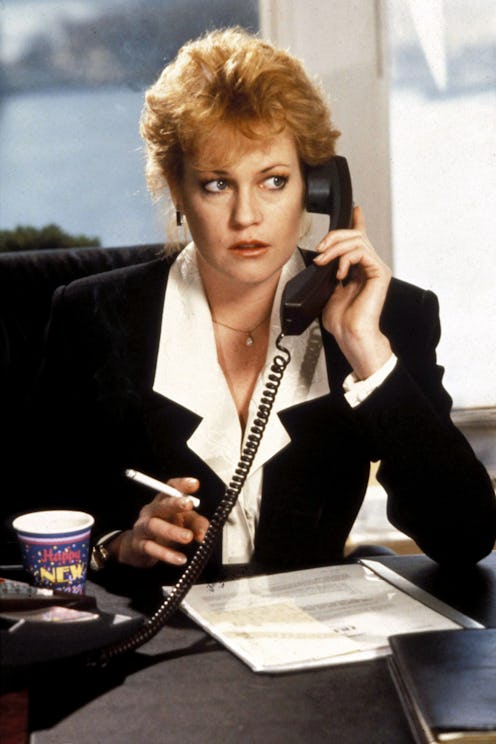(Film)
How '80s Rom-Com Working Girl Pioneered The Power Suit
The look is still so relevant today.

These days, a girl strutting down the street in a bold suit and sneakers would be nothing to bat an eyelash at. In fact, a structured pant set has become a fashion essential in many a wardrobe. However, some 35 years ago, the look was revolutionary and synonymous with an iconic ‘80s rom-com — and the powerful women who starred in it. Of course, we are referencing Working Girl, the 1988 Oscar-winning film that celebrates a milestone anniversary today (and is reported to be getting a reboot soon produced by one Ms. Selena Gomez). I recently rewatched the modern-day Cinderella tale, and as a 38-year-old “working girl” myself, I truly saw the story in a whole new light. In fact, upon closer inspection, I was able to see the clothes — more specifically the suiting — as more than just trend-setting looks that would stand the test of time, but subtle representations of the main characters’ career journeys.
You see, from the jump, co-ords of all kinds played a pivotal role in the character development of Staten Island secretary Tess McGill, played by a breathy-toned Melanie Griffith. At lights up, the blonde bombshell is seen commuting on the ferry into the big city to the tune of Carly Simon’s anthem “Let The River Run” in an oversized, boxy beige skirt suit, which she pairs with sheer black tights and chunky white dad sneakers. While it girls like Gigi Hadid and Emily Ratajkowski have championed this contradictory look in recent years, in 1988, it pointed to McGill’s struggle up the corporate ladder, which required clothing and accessories that helped her both look the part and made the journey a bit easier (at least until she reached her temp agency office, where she quickly swapped out her practical trainers for more professional pumps).
“It was the 1980s with a Staten Island flavor,” said the film’s costume designer Ann Roth in Deborah Nadoolman Landis’ book Dressed: A Century of Hollywood Costume Design. “They usually don’t come to Manhattan, but those girls who come and work as secretaries, getting off the boat, their shoes would be in their purses… and they were sexy. That’s the point. They were very sexy.”
The thing is, Tess wasn’t looking to turn heads. She wanted to be successful and a respected professional. So, her look needed to follow suit — literally. While not as pronounced as other bygone rom-coms like Pretty Woman and Clueless, the heroine’s style-centric makeover montage is certainly intentional and crucial to her plight in the film. But it’s also gradual. As she begins working for ruthless mergers and acquisitions executive Katharine Parker (played by a brilliant Sigourney Weaver), Tess slowly starts to adopt her superior’s elevated style and the office dress code, which Katharine describes in the film as “Simple. Elegant. Impeccable.”
In a 1989 interview with the Los Angeles Times, the film’s assistant costume designer Gary Jones said, “When Katharine tells Tess, ‘You might rethink your jewelry,’ she not only rethinks, she starts to make some major changes [...] That character gets it. If she’s going to leave one place and go to another, she also has to start looking different. It’s all about change and the clothes are part of it.”
After she takes over for an injured Katharine — who breaks a leg in a skiing accident — Tess’ “fake it ‘til you make it” mentality really takes flight, and her wardrobe becomes symbolic of this ascension to the top (even if it’s all a ruse). Her oversized, ill-fitting suits suddenly become better tailored to her frame, her gaudy jewelry replaced by luxe pearls and delicate, fine baubles, her heavy, smokey-eyed makeup more natural and radiant, and — the pièce de résistance — her big, teased-out Farrah Fawcett mane cut short into a more defined, chin-length bouncy bob. Tess means business and her more streamlined appearance reflects it.
By the end of the film, Tess is the very picture of a Wall Street executive, while still allowing that aforementioned Staten Island sultriness to exude in her aesthetic. It’s in her silky smooth yet unapologetic words (“I have a head for business and a body for sin. Is there anything wrong with that?”) and perfectly tailored neutral power suits. Through her style, Tess manages to strike a nice balance between her masculine and feminine energy, which is likely why the power suit remains, well, so powerful to this day.
So, the next time you see a woman running around town in a fierce pants set with sneakers or a sleek heel, remember who did it first — and why she did it. Cheers to the OG working girl.